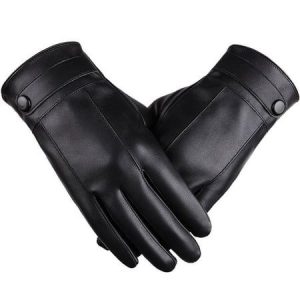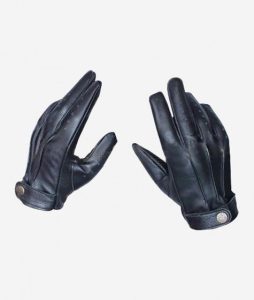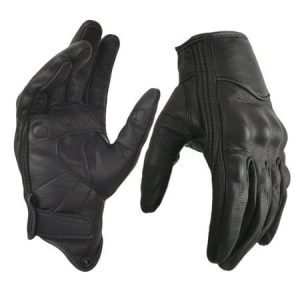A Guide to Choosing the Best Motorcycle Gloves
For motorcycle riders, safety is paramount. While a helmet is undoubtedly the most crucial protective gear, safeguarding your hands is equally important. Motorcycle gloves shield your hands from abrasions, impacts, and the elements, potentially preventing serious injuries in the unfortunate event of an accident. But with a vast array of motorcycle gloves available, selecting the right pair can be daunting. This comprehensive guide equips you with the knowledge to navigate the world of motorcycle gloves and choose the perfect pair to keep your hands protected and comfortable on every ride.
Understanding Your Needs: Selecting Motorcycle Gloves for Riding Style
The ideal motorcycle gloves cater to your specific riding style and preferences. Here’s a breakdown of popular glove types:

- Full-Gauntlet Gloves: Offering maximum protection, full-gauntlet gloves extend past the wrist, covering the forearm and often incorporating knuckle armor. These gloves are ideal for sportbike riders and those seeking the most comprehensive protection.
- Short-Cuff Gloves: Designed for a balance between protection and comfort, short-cuff gloves typically reach the wrist or mid-forearm. They provide ample protection for everyday riding and are popular among streetfighter and cruiser riders.
- Summer Gloves: Prioritize airflow and ventilation for hot weather riding. Summer gloves often feature lightweight, breathable materials like mesh or perforated leather.
- Winter Gloves: Focus on warmth and insulation for cold weather riding. Winter gloves are typically constructed from thicker materials and may incorporate thermal liners.
- Touring Gloves: Designed for long-distance comfort, touring gloves offer a balance between protection and weatherproofing. They often feature features like padded palms and touchscreen compatibility.
Understanding your riding style and the climate you’ll be riding in will guide you towards the most suitable type of motorcycle gloves.
Safety First: Essential Features of Motorcycle Gloves
Beyond style and comfort, prioritize these safety features when choosing motorcycle gloves:

- Abrasion Resistance: Look for gloves constructed from high-abrasion-resistant materials like leather or heavy textiles. Leather offers excellent abrasion resistance, while textile gloves can be more breathable and affordable.
- Impact Protection: Many gloves incorporate padding or armor on the knuckles, fingers, and palm to shield your hands from impacts during a fall.
- Wrist Closure: A secure wrist closure prevents the gloves from coming off in a crash. Look for gloves with adjustable straps or velcro closures for a snug fit.
Additional Safety Considerations:
- Touchscreen Compatibility: Many gloves incorporate fingertips that allow you to operate touchscreen devices without removing your gloves – a valuable convenience in today’s tech-driven world.
- Reflective Materials: Opt for gloves with reflective materials to enhance your visibility to other motorists, especially important for low-light riding conditions.
Remember, your motorcycle gloves are a crucial part of your safety gear. Don’t compromise on protection – choose gloves that offer the necessary features to keep your hands safe.
Material Matters: Selecting the Right Construction for Your Gloves
The materials your motorcycle gloves are constructed from significantly impact their functionality, durability, and comfort:

- Leather: A traditional and highly regarded material for motorcycle gloves, leather offers excellent abrasion resistance and a comfortable, form-fitting feel as it breaks in. However, leather gloves can be pricier and require more maintenance to keep them supple.
- Textiles: Modern textile materials like Cordura and Kevlar offer impressive abrasion resistance while being lighter and often more breathable than leather. Textile gloves can also be more affordable and easier to care for.
- Mixed Materials: Many gloves combine leather and textile materials to create a hybrid option that leverages the strengths of both. For instance, you might find gloves with leather palms for abrasion resistance and textile uppers for breathability.
Choosing the Right Leather:
- Cowhide: The most common and affordable type of leather used in motorcycle gloves, cowhide offers a good balance of durability and comfort.
- Goatskin: A softer and more supple leather than cowhide, goatskin provides excellent dexterity and comfort but may not be as abrasion-resistant.
- Kangaroo Leather: The pinnacle of motorcycle glove leather, kangaroo leather is incredibly abrasion-resistant, lightweight, and offers superior comfort. However, kangaroo leather gloves tend to be the most expensive option.
Considering Climate:

- Summer: For hot weather riding, prioritize lightweight, breathable materials like mesh or perforated leather. These materials allow for airflow and help keep your hands cool.
- Winter: When battling the cold, select gloves constructed from thicker materials like insulated leather or textiles with a thermal lining. Winter gloves should also provide a snug fit to retain warmth.
Matching the material of your motorcycle gloves to your riding style and climate ensures optimal performance and comfort.
Finding the Perfect Fit: Ensuring Comfort and Safety
A well-fitting motorcycle glove is vital for both comfort and safety. Gloves that are too loose can bunch up and compromise your grip on the handlebars, while excessively tight gloves can restrict blood flow and dexterity. Here’s how to find the perfect fit:
- Measure Your Hands: Most online retailers and glove manufacturers provide sizing charts. Measure the circumference of your hand at its widest point (excluding the thumb) to determine your recommended glove size.
- Try Before You Buy: Whenever possible, try on different pairs of gloves to assess the fit. The gloves should feel snug but not constricting. You should be able to comfortably curl your fingers and grip handlebars without excessive bunching.
- Consider Break-in Period: Leather gloves typically conform to your hand shape over time, so a slightly snug fit initially is acceptable. However, textile gloves should feel comfortable from the outset.
Finding the perfect balance between a secure fit and comfortable wear ensures you can ride for extended periods without hand fatigue or restricted movement.
Caring for Your Investment: Maintaining Your Gloves
Proper maintenance extends the lifespan and functionality of your motorcycle gloves. Here are some after-ride care tips:

- Cleaning: Gently clean your gloves with a damp cloth and a mild soap solution after each ride. This removes dirt, sweat, and grime that can degrade the materials over time.
- Drying: Allow your gloves to air dry completely out of direct sunlight. Avoid using heat sources like dryers, as this can damage the leather or textiles.
- Leather Conditioning (if applicable): For leather gloves, periodic conditioning with a leather care product helps maintain suppleness and prevent cracking. Follow the manufacturer’s recommendations for the specific type of leather.
- Storage: When not in use, store your motorcycle gloves in a cool, dry place away from direct sunlight.
By following these simple care tips, you can ensure your motorcycle gloves continue to provide optimal protection and comfort for many rides to come.
